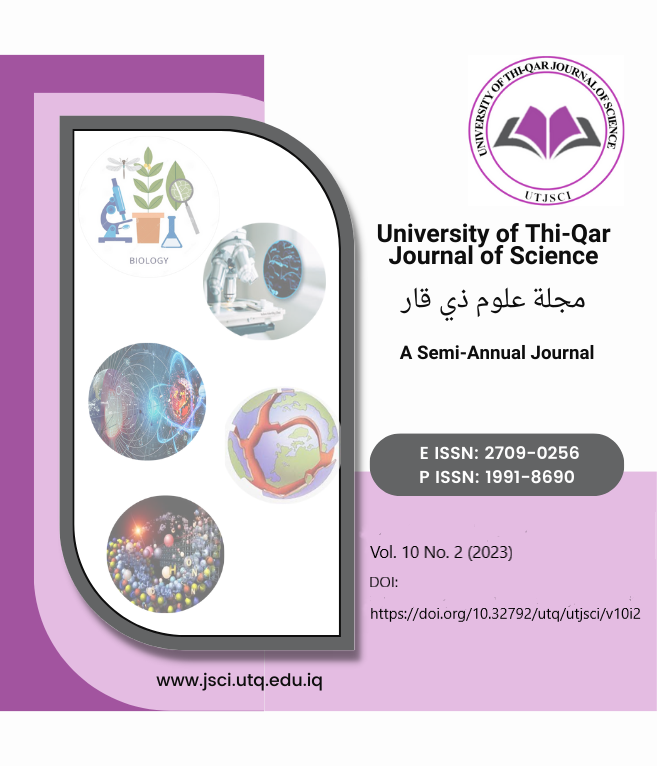Study of insulin resistance, cortisol hormone and some biochemical parameters in Iraqi type 2 diabetic patients
DOI:
https://doi.org/10.32792/utq/utjsci/v10i2.1087Keywords:
This my manuscript trigger to evaluation insulin resistance, cortisol hormone and some biochemical parameters in type 2 diabetesAbstract
The most prevalent type of diabetes disease is type 2. It resulted through cells' failure for recognizing and responding to insulin, which can increase the risk of this disease if improperly managed. This work seeks to assess few biochemical variables connected to glycemic index in people with type 2 diabetes (T2D). In this study, certain biochemical markers were taken from 37 patients with diabetes mellitus (DM). In the current study, lipid profile, kidney function, insulin, glycated hemoglobin (HbA1c), fasting blood sugar (FBS), uric acid, insulin resistance (HOMA-IR) and cortisol hormone were measured. The blood serum of the 37 patients were taken from diabetic center in Yarmouk hospital and 27 control sample were taken from healthy people in the University of Baghdad. The ages for healthy and unhealthy patients were (19 to 47 ) years old. The results showed that, diabetic participants had higher HbA1c, FBS, HOMA-IR, cortisol, urea, uric acid, lipid profile, and creatinine levels comparing to the control samples at P≤0.05. We concluded from this study, abnormally elevated levels of serum cortisol, FBS, HbA1c, and insulin. Increasing HOMA-IR indicated that IR is a risk factor for T2DM development. This work revealed a relationship between T2DM and kidney function parameters. It was found that patients with T2D having higher levels of creatinine and urea.
Received: 2023-07-10
Revised: 2023-07-23
Accepted: 2023-07-29
References
L.C. Martinez, D. Sherling, and A. Holley, A. "The Screening and Prevention of Diabetes Mellitus:. Prim Care. 46(1):41-52, 2019.
V.A. Salunkhe, R. Veluthakal, S.E. Kahn, and D.C. Thurmond, D.C. "Novel approaches to restore beta cell function in prediabetes and type 2diabetes" Diabetologia, 61, pp. 1895-1901, 2018.
J.A. Tura, I. Bagger, E. Ferrannini, J. Holst, F.K. Knop, and T. Vilsbøll, "Impaired beta cell sensitivity to incretins in type 2 diabetes is insufficiently compensated by higher incretion response" Nutrition, Metabolism, and Cardiovascular Diseases, 27, pp. 1123-1129, 2017.
M. Matthäus, James, C. O'Hare ,Bob, P. Michelle, B. Christoph, and S. S. Thomas, "Brain insulin signaling suppresses lipolysis in the absence of peripheral insulin receptors and requires the MAPK pathway". Molecular Metabolism. Volume 73, 101723, 2023.
W. Richmond, ".Determination of cholesterol by enzymatic method" Clin Chem .19: 1350-1356, 1973.
M. Burstein, "Measurement of lipid profile". Lipid Res, 11: 583, 1973.
P. Fossatti, and Prencipel, "Determination of triglycerides by enzymatic method".Clin.Chem, 28: 2077, 1982.
W.T. Friedewalds, R.I. Levy, M. Wite, and D.S. Fredrickson, "Estimation of the concentration of low density lipoprotein Cholesterol in plasma without the use of preparative ultra Centrifuge". Clin. Chem, 18: 499-502, 1972.
T. Glover, andK. Mitchell, K. "An introduction to Biostatistics, 2nd ed. Waveland press".Inc. Third Edition, 2008.
A. Nuha, G.A. ElSayed, R. Vanita, Aroda, R. Raveendhara, and M. Bannuru, et al." Obesity and Weight Management for the Prevention and Treatment of Type 2 Diabetes: Standards of Care in Diabetes—2023". Diabetes Care .46(Suppl. 1):S128–S139, 2023.
R. Rosario, C. Carmen, N. Rosarita, R. Virgilio, D. Emmanuele, and M. Mariorosario, et al., "Novel Reversible Inhibitors of Xanthine Oxidase Targeting the Active Site of the Enzyme". Antioxidants , 12, 825, 2023.
Masannagari , G. Pallavi, Sudarshan ,N.R.V. Sri, N. Ranjithvishal, and L. Shruthi, et al., "Influence of Uric Acid on Erythrocytes Subjected to H2O2-Induced Oxidative Stress". Applied in vitro toxicology. Vol.9, No.2, 2023.
C. Mehrdad, F. Mehran, FD. Majid, and A. Saeid, "Evaluation of the relationship between serum uric acid level and proteinuria in patients with type 2 diabetes". J Clini Nephrol. 7: 001-006, 2023.
M. Diego, S. Luca, C. Martina, N. Lorenzo, F. Giovanna, and N. Andrea et al., "Glomerular Hyperfiltration Predicts Kidney Function Decline and Mortality in Type 1 and Type 2 Diabetes: A 21-Year Longitudinal Study". Diabetes Care, 1;46(4):845-853, 2023.
H.M. Abdulwahed, "Correlation between HbA1c and lipid profile in patients with Type2 diabetes mellitus". Kirkuk Journal of Medical Sciences - Volume 11/ Issue 1, 2023.
K. Jaewon, M.K. Sung, C. Jooyoung, C. Seulggie, L. Gyeongsil, and S.S. Joung, et al."Changes in total cholesterol level and cardiovascular disease risk among type 2 diabetes patients". Scientifc Reports, 13:8342, 2023.
A. Rama, S.D. Vaidya , M. Panchali, S. Shery, A. Shubhada, and B. Rekha, et al. "Hyperinsulinemia: an early biomarker of metabolic dysfunction". Frontiers in Clinical Diabetes and Healthcare, Volume 4, 2023.
X. Eva, N. Ioanna, C. Eleftheria ,Sagiadinou, Z. Evangelia, and E.K. Kyriakos, "HDL and type 2 diabetes: the chicken or the egg?". Diabetologia volume 64, pages1917–1926, 2021.
L. Feng, M. Guanhui, T. Chao, Z. Shan, Y. Xinghua, and X. Cong, et al."Elevated blood urea nitrogen-to-creatinine ratio increased the risk of Coronary Artery Disease in patients living with type 2 diabetes mellitus". BMC Endocrine Disorders ,volume 22, Article number: 50, 2022.
A. Abdulrahman, "Prevalence of diabetic nephropathy among type 2 diabetic patients in some of the Arab countries". Int J Health Sci (Qassim). 11(1): 1–4, 2017.
Downloads
Published
License
Copyright (c) 2023 University of Thi-Qar Journal of Science

This work is licensed under a Creative Commons Attribution 4.0 International License.













